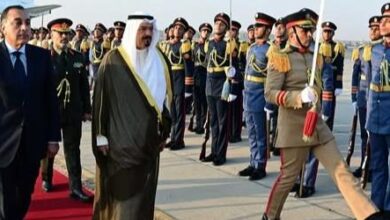“Loyalty to the homeland, enmity to the Brotherhood.” This campaign slogan, adopted by the incumbent parliamentary candidate Nabil al-Fadhl, summarizes the line taken by many pro-government politicians and media outlets in reaction to Kuwait’s protest movement.
Last month, the country experienced an upsurge in peaceful mass demonstrations in response to the emir’s unilateral amendment of the electoral law. While security forces dispersed the protesters, pro-government elements sought to discredit the popular movement by portraying it as a Muslim Brotherhood conspiracy.
This narrative holds that the Kuwaiti branch of the group is seeking to foment a revolution on the Egyptian model. It also accuses it of serving foreign powers, including the Egyptian-led Muslim Brotherhood international organization, and governments such as Qatar and even the US.
While the Kuwaiti government has stopped short of explicitly blaming the Brotherhood for the unrest, statements by some officials have lent support to these theories. For example, in response to a question about the group’s involvement in the protests, the cabinet minister Rula Dashti stated, “There is no doubt we are facing a well-structured organization [tanzim] that exceeds the normal political groups and youth movements.”
For their part, representatives of Kuwait’s Muslim Brotherhood have strenuously denied these accusations.
The Brothers and revolution
The attribution of Kuwait’s protest movement to the machinations of the Brotherhood is in fact based on a facile equation with the Egyptian situation. Not only does the case of Kuwait differ in that the goals of its opposition are reformist rather than revolutionary, but Kuwait’s Muslim Brotherhood itself is also markedly different from its Egyptian counterpart.
Two key factors make it extremely unlikely that the Kuwaiti Brotherhood would have the intention or the ability to attempt a revolution in the country.
The first of these is the long history of friendship between Kuwait’s Muslim Brotherhood and the ruling family. Indeed, until the last several years, the most common accusation leveled against the Brotherhood by its opponents was collusion with the government.
The roots of this relationship date to the 1960s, when deputies affiliated with the group participated in forming a loyalist bulwark in parliament against the Arab nationalist opposition. This coordination developed into a full-scale alliance in the 1970s, when the government allowed the Brotherhood to penetrate government ministries.
While similar pacts between governments and Islamists elsewhere in the region eventually collapsed, Kuwait’s Brotherhood continued to enjoy exceptionally close relations with the regime, even as it grew more independent and oppositional in the late 1980s and 1990s.
Generations
Over the last decade, a number of factors including the increasing influence of younger members within the Brotherhood have led the group to align itself more closely with the opposition. Nevertheless, older and more conservative elements remain influential.
For example, Humud al-Rumi, the head of the Brotherhood’s Social Reform Society, recently spoke out against the opposition’s direct criticism of the emir.
The generational divide within the group became apparent when a former Brotherhood deputy, the firebrand Jam’an al-Hirbish, declared that Rumi’s statement did not represent him.
However, the more aggressive stance of the younger members did not prevent two delegations of senior Brotherhood figures, including Rumi, from visiting the emir in order to affirm their loyalty and deescalate the situation.
Limited popularity
The second factor that would inhibit Kuwait’s Brotherhood from pursuing a revolutionary course is its relatively limited popularity.
Although the political arm of the Brotherhood, the Islamic Constitutional Movement (ICM), is frequently cited as the most organized political group in Kuwait, this is not saying much.
In the absence of a legal framework for political parties, the influence of ideological political groups in the country pales in comparison to resurgent tribal and sectarian loyalties. The highest number of parliamentary seats ever won by the ICM was a modest six out of 50 in the 2006 elections. These seats have been further reduced since the opposition pushed through a law reforming the electoral districts.
Ironically, many of the same pro-government voices currently speaking of a Brotherhood conspiracy predicted that these reforms would lead to sweeping victories for the ICM.
However, it was in fact the tribes that gained the most from the larger districts and the ability to run electoral lists. The ICM, by contrast, has only garnered between one and four seats in the elections held since then. The tribes also now form the backbone of the protest movement. In addition, other groups within the opposition coalition, such as the secular Popular Bloc, are just as influential as the ICM, if not more so.
Government propaganda
The Muslim Brotherhood forms but one piece in the disparate mosaic of the Kuwaiti opposition, whose constituents represent a wide array of Islamist, secular, and tribal orientations. Moreover, the group is by no means the most radical of these factions, nor is it the most powerful.
Attempts to assign the Brotherhood undue influence in the current protest movement must be seen as yet another example of the all too familiar propaganda deployed by governments and their allies during the Arab Spring.
The theme of the foreign-backed conspiracy is central to all these campaigns to discredit popular opposition, whether the bogeyman in question is the Brotherhood, Iran, or other actors.
Talal al-Rashoud is a PhD candidate in history at the School of Oriental and African Studies.




